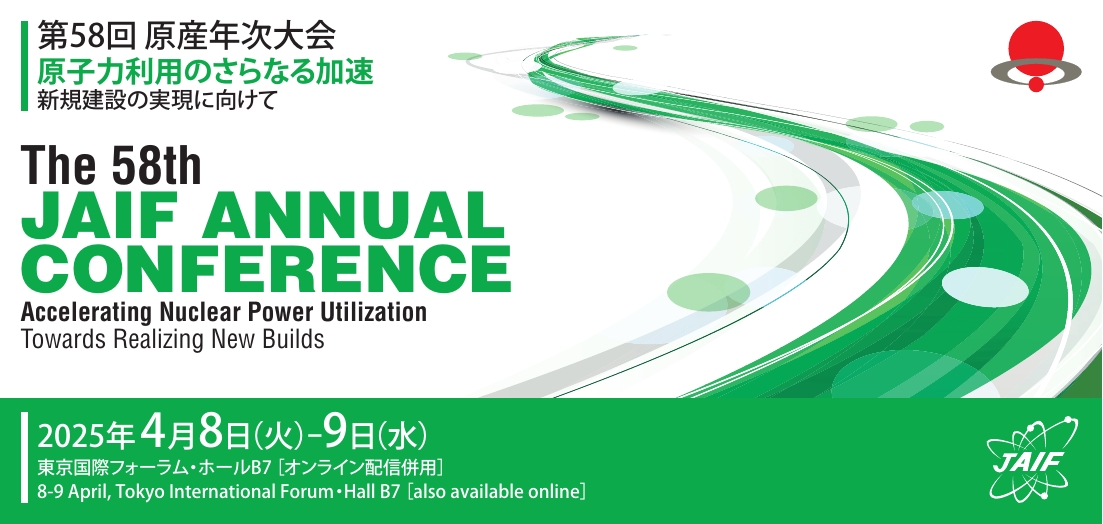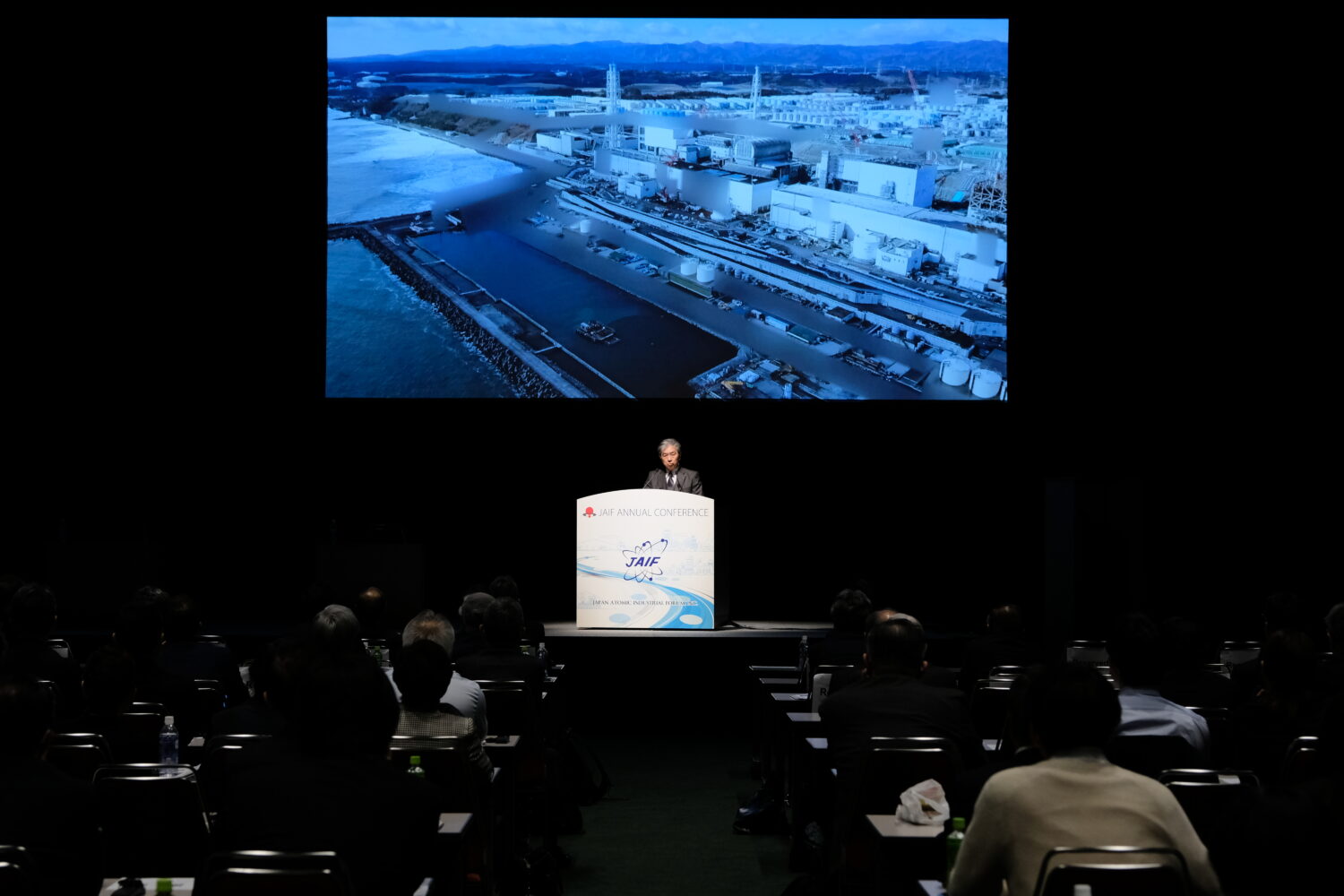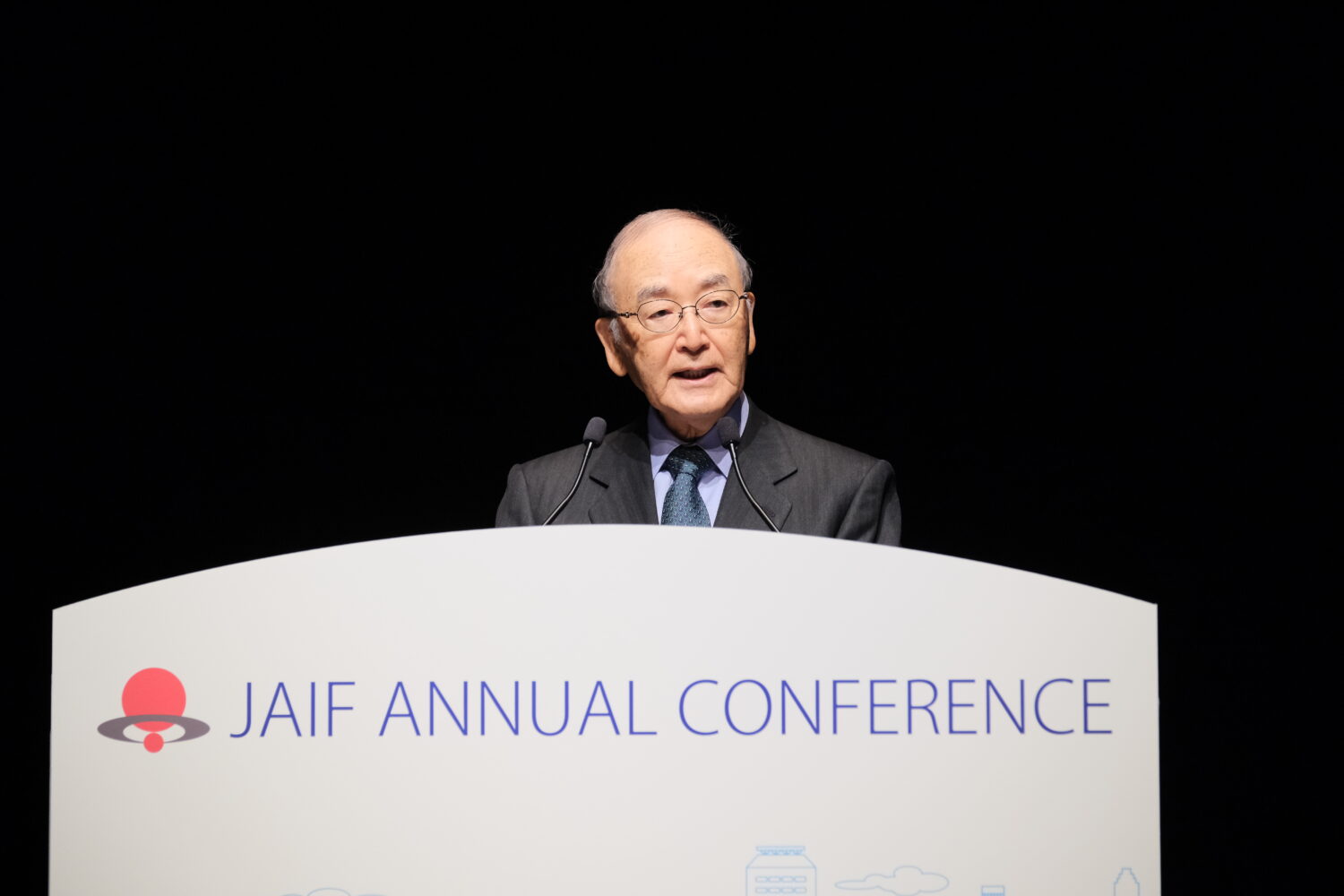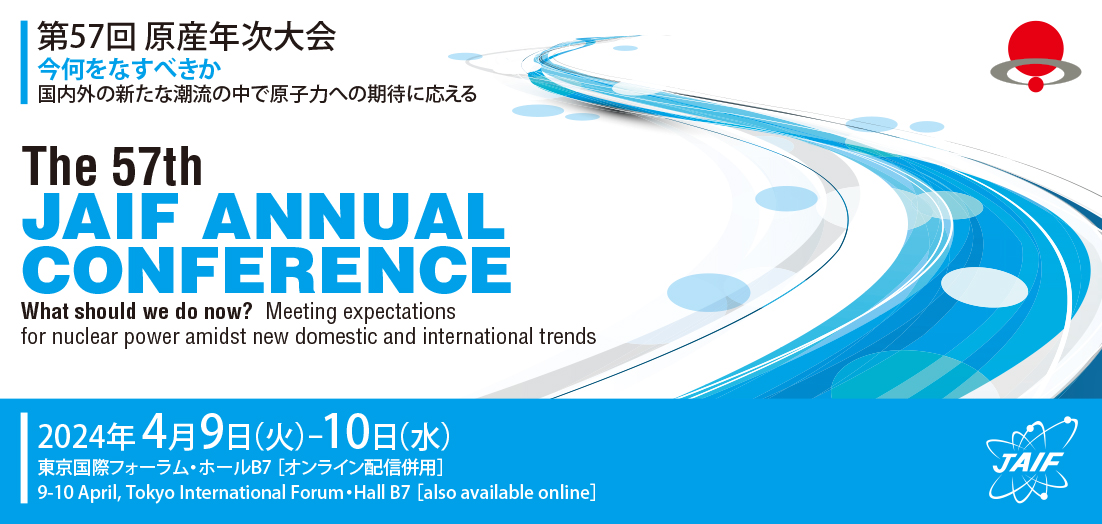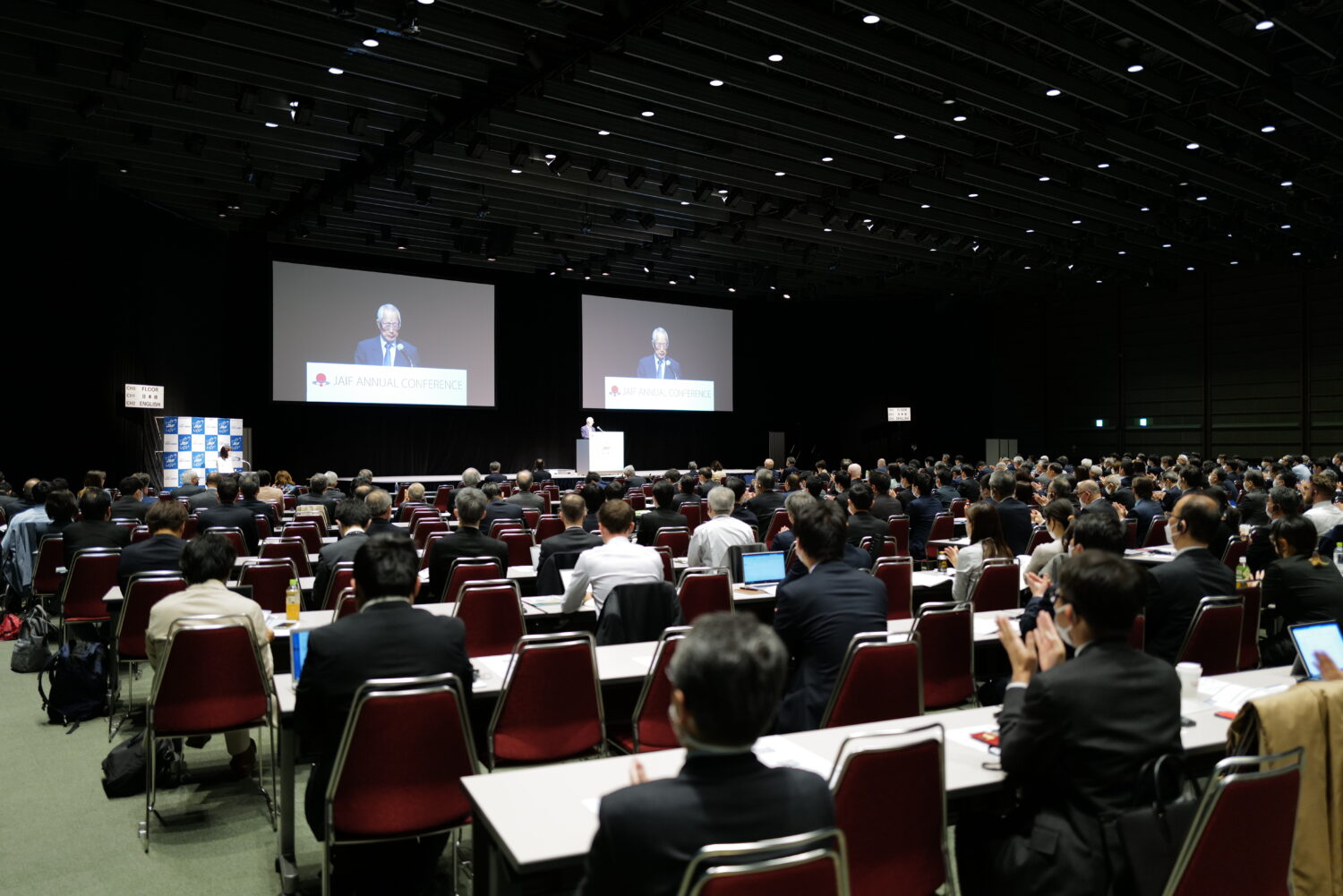This year, the tenth since the accident, participants again exchanged views and opinions on future prospects in reconstruction of Fukushima, in the context of the current state of decommissioning at the NPPs.
At the start of the session, a report on the current status of the Fukushima Daiichi NPPs and related issues was given by Akira Ono, managing executive officer, chief decommissioning officer and president of the Fukushima Daiichi Decontamination and Decommissioning Engineering Company, Tokyo Electric Power Company Holdings.
He prefaced his remarks by saying that he had reflected on the recent incident related to physical protection of nuclear materials at Kashiwazaki Kariwa NPPs of the Tokyo Electric Power Co. (TEPCO), and apologized for it.
In 2020, Ono said, the generation of contaminated water at the Fukushima Daiichi had been reduced to 140m3 per day thanks to the control of the inflow of groundwater and rainwater. Enough tanks had been secured by the end of 2020 to store some 1.37 million tons of water treated by multi-nuclide removal equipment (the Advanced Liquid Processing System, or ALPS).
 As of February 2021, the volume of ALPS treated water stored in tanks stood at approximately 1.25 million tons. The installation of even more tanks to store treated water beyond the planned volume, he said, would potentially interfere with the construction of facilities and equipment necessary for decommissioning, affecting the progress of the entire effort thereafter.
As of February 2021, the volume of ALPS treated water stored in tanks stood at approximately 1.25 million tons. The installation of even more tanks to store treated water beyond the planned volume, he said, would potentially interfere with the construction of facilities and equipment necessary for decommissioning, affecting the progress of the entire effort thereafter.
Moreover, the government announced its decision on April 13 to release the ALPS-treated water over time into the sea. Addressing that, Ono said, “TEPCO will coordinate its treatment actions from now on with the relevant and concerned parties, and will faithfully implement the government’s policy.”
He then briefly referred to the removal of fuel from the spent fuel pools, as well as the progress toward removing fuel debris, the management of solid waste, and the synergy between reconstruction and decommissioning. He said, “In particular, we must consider how we can use the decommissioning of Fukushima Daiichi to advance the reconstruction effort. The key is getting local companies more involved.”
He then expressed his intention to increase the number of explanatory meetings for companies, and to match opportunities between local companies and existing contractors.
Turning to the issue of information not being conveyed in a timely manner, Ono cited the example of a significant earthquake that occurred on February 13 almost three months ago, when it was found that the seismometers at the Unit 3 reactor building at Fukushima Daiichi were inoperative, having been left unfixed after being damaged in heavy rainfall in July 2020.
Acknowledging a gap between TEPCO’s approach and what local people had expected, Ono said that it was “first necessary to close that gap,” and that “TEPCO wanted to work on bilateral communications.”
 Next, relatively young panelists who have been involved on the front line of Fukushima reconstruction took up the theme of “Ten Years after the Earthquake, Toward the Future of Fukushima.” William D.Y. McMichael, deputy director, International Center, Fukushima University, served as moderator.
Next, relatively young panelists who have been involved on the front line of Fukushima reconstruction took up the theme of “Ten Years after the Earthquake, Toward the Future of Fukushima.” William D.Y. McMichael, deputy director, International Center, Fukushima University, served as moderator.
One of the panelists, Tomoyuki Wada, CEO of Odaka Workers Base, was born and grew up in the Odaka District of Minamisoma City in Fukushima Prefecture. Before the massive earthquake of March 11, 2011, he had already returned to his hometown after spending his university years in Tokyo in order to set up and operate a local IT venture there. However, he was then forced to evacuate because of the Fukushima Daiichi accident.
In February 2014, Wada established the Odaka Workers Base in the district, which was at the time under an evacuation order (that is, no residents were permitted to live there). In July 2016, though, the evacuation order was lifted, and people began to return to their homes. Although the population had once exceeded 12,000, it is now about 3,700, or just one-third of the original number. Almost half are elderly, and the number of children is low, resulting in an aging population with an extremely low birthrate.
“These are grave circumstances, and the community faces many challenges, discouraging people from returning home. Seen from a different angle, however, each issue can be looked at as the seed of a business opportunity. There are businesses waiting to be born here, and only here,” Wada stated with an air of defiance.
 He began by creating a “co-working space” in the town at a time when no people were there. He then created a dining space and a temporary supermarket. Although the living environment was in place, few younger people came back. He then started up a studio to make glass accessories appealing to young people, and several young local women started working there. That led to the opening of a coffee shop, which more young people patronized. A virtuous cycle was thus born.
He began by creating a “co-working space” in the town at a time when no people were there. He then created a dining space and a temporary supermarket. Although the living environment was in place, few younger people came back. He then started up a studio to make glass accessories appealing to young people, and several young local women started working there. That led to the opening of a coffee shop, which more young people patronized. A virtuous cycle was thus born.
In its new phase, the base is providing support to creative entrepreneurs who believe in the potential of the area, thus actively building the community. Eight entrepreneurs are now based there.
Wada has also set up the Working Space “Odaka Pioneer Village,” complete with a guesthouse and kitchen. The village serves as a place for local businesspeople and visitors to interact, with a growing number of people now working together there, albeit remotely during the coronavirus pandemic.
The Odaka Workers Base has also launched projects to support young entrepreneurs—who had been in their teens at the time of the earthquake a decade ago—and to develop human resources.
Wada said, “Eventually I want this area to be self-supporting. Modern Japan is both rich and mature thanks to the endeavors of our predecessors, but many people have a sense of despair. The reality, however, is that nothing exists in the area, so there is no choice but to create something new. In that sense, our area could be seen as modern Japan’s final frontier. Looking forward to an unpredictable future, I will exploit it.”
 Another of the panelists was Tokyo-born Tamami Henmi of Futaba Future Meeting at the Futaba Information Center, who studied nuclear engineering in college, focusing on radiation and similar subjects. In 2011, in the wake of the Fukushima Daiichi accident, she assisted children from Tomioka Town in their studies after they had evacuated to Tokyo. Her ties with Futaba-gun were established then.
Another of the panelists was Tokyo-born Tamami Henmi of Futaba Future Meeting at the Futaba Information Center, who studied nuclear engineering in college, focusing on radiation and similar subjects. In 2011, in the wake of the Fukushima Daiichi accident, she assisted children from Tomioka Town in their studies after they had evacuated to Tokyo. Her ties with Futaba-gun were established then.
In 2012, she moved to Kawauchi Village, where, as a staff member of the Fukushima University Kawauchi Village Satellite, she helped residents through consultations on radiation and other matters.
Henmi then moved to Tomioka Town in 2020. As a staff member of Futaba Future Meeting, Futaba Information Center, she has worked to disseminate information on Futaba-gun, and has also been involved in various grass-root activities.
Pointing to a map, Henmi referred to the history of the area, saying, “Historically, people here would work in Tokyo in winter, away from home. That arrangement ended when the area became a power-supply region, generating and supplying electricity to Tokyo.”
She then looked at the shifts occurring in areas under evacuation orders. Showing a graph comparing the number of employees of each power company, she said that 22,332 people had once lived in areas now designated as places “where residents will not be able to return home for a long time.”
“The nuclear accident meant the loss of everything up to that time,” Henmi said. “How happy routines can be: people, objects, things, memories. Around me are young people with complicated states of mind. They experienced the earthquake when they were elementary students. The rows of cherry trees in Yonomori in Tomioka Town used to be part of their lives, but now they are removed from them by barricades because they are situated in the ‘area under an evacuation order.’ Those young people now feel that those cherry trees are ‘special.’ At the same time, they are pained, angry at themselves, for having such feelings at all.”
With such young people in mind, Henmi continues to go about her work in Futaba-gun. Armed with the slogan of “Let’s enjoy village life” in Kawauchi, along with the aim of a future renewed, the Futaba Information Center plans enjoyable projects for villagers and outsiders alike.
One such project, staged at a local poultry farm—certainly unlike anything available in places like Tokyo—was called, “Let’s make sausage . . . starting with a chicken.” Another project, called “Dining Place for Kids” (Tomioka Kodomo Shokudo), is unique in trying to recreate regional communities through children, including returnees and those of workers who have come to the decommissioning site.
“The nuclear accident has had wide-ranging ramifications, from evacuation to separations, the rapid aging of the population, the collapse of communities, and divergences in thinking. Those things could, however, happen anywhere,” Henmi said.
She continued, “To make a better future requires persistence. People must get to know each other. There must be repeated dialogues, followed by understanding. That may seem to be the long route, but is actually the faster way. That may be a key to solutions to various problems.”
Addressing nuclear-related people, Henmi emphasized, “I hope the flow of thinking will not be one-way at explanatory meetings and public hearing on such things as plant restarts and the release of treated water into the sea. I hope that discussions will take place at those venues based on the understanding that different people have different viewpoints.” She then invited nuclear-related persons to come to Futaba-gun to listen to what the people living and working there really want.
 The third of the young panelists was Naoya Maekawa, director and executive secretary of the Fukushima Manabi-no Network, who was born in Amagasaki City in Hyogo Prefecture. On January 17, 1995, while a senior in high school, he experienced the giant earthquake that struck Kobe and the surrounding area. After graduating from university, he taught at two of his alma maters, the Nada Junior and Senior High Schools.
The third of the young panelists was Naoya Maekawa, director and executive secretary of the Fukushima Manabi-no Network, who was born in Amagasaki City in Hyogo Prefecture. On January 17, 1995, while a senior in high school, he experienced the giant earthquake that struck Kobe and the surrounding area. After graduating from university, he taught at two of his alma maters, the Nada Junior and Senior High Schools.
In the wake of the 2011 earthquake that struck eastern Japan, he often visited Fukushima with his students, and became interested in working there. Three years later, he moved to Fukushima City, establishing a nonprofit organization (NPO) there called the Fukushima Manabi-no Network. Since 2018, he has also served as a specially appointed associate professor at Fukushima University.
So far, Maekawa has held fourteen free seminars for high school students in Fukushima, inviting his former colleagues, and leading preparatory schoolteachers as guest teachers. The teachers at the seminars have all been volunteers. Their classes have been so compelling that they have drawn many repeat attendees. “To be helpful to someone else—which is what cool (kakko-ii) adults do—one must have the ability to do so. That, I tell the students, is what school is for.”
Two decades from now, Japan may have entered an age when robots and AI have taken over human work. Robots and AI, however, can never answer subjectively the question of what people should identify as the issues and figure the answers out for themselves. It is only people who can consider what should be done in Futaba-gun to restore their daily lives and make decisions about it.
In Fukushima, high school students are carrying out a wide variety of activities for reconstruction and making regional contributions across the prefecture. Recognizing those students’ activities as “service learning,” Fukushima Manabi-no Network wants to further invigorate them.
Fukushima University, meanwhile, emphasizes a program of practical learning on local issues, called “Fukushima Future Studies.”
Maekawa said, “In Fukushima, you may feel that learning at school is not for you but for someone else. Instead of learning at school, with too much emphasis on academics, you can meet your subjective challenge in Fukushima. It is there that Japanese education, which has been pushed to the limit, can be changed.”
At the same time, Maekawa said that he felt honestly “bashful” as an educator to be bound by Fukushima issues and to have “attached” the students to reconstruction, although he was proud of their activities. Recognizing that conflict within himself, Maekawa said that he continually tries to deal with students both openly and directly.
In the following panel discussion, McMichael—who describes himself (as do others) as “a Canadian who is the No. 1 fan of Fukushima”—asked the panelists what their vision was for the “ideal Fukushima” three decades from now.
Odaka Workers Space CEO Wada predicted that residents would become self-supporting by “creating a hundred businesses out of a hundred problems”—similar to the way his own company views its mission—and that he hoped now to ferment a climate in which people could launch new endeavors and projects in the very areas that had been under evacuation orders.
Futaba Future Meeting’s Henmi predicted that the stratum or layer (chiso) of society would be restored upon which the cultivation (machi wo tagayasu) of towns in Futaba-gun could proceed. In the countryside, people’s livelihoods had been wiped away because of the nuclear accident, and their memories were shaved off by decontamination (josen), causing them to feel that something was missing as a town.
In other words, in a land whose residents had once all been forced to disappear, and whose livelihoods there had been lost, it is their lives now that will fill the void left by what is gone, to use the metaphor of soil (tsuchi) having once been removed. Three decades from now, she said that those lives—the removed layer, so to speak—will have been restored.
The vision of Fukushima Manabi-no Network’s Maekawa for the area thirty years from now was for it to serve as the “last fortress for the Earth and humanity.” It is essential, he said, that “its lessons be continually conveyed.” We must not turn the accident at the NPPs into a mere fact of history, he said, but carry within each of us the reality of the failure, having faced it squarely.
Finally, McMichael asked the panelists, “What do you hope to see from the nuclear industry?”
Wada answered, “The common wish is for a happy society. If there is anything the industry and we can do together toward that, we will collaborate.” Meanwhile, Henmi pointed out that nuclear power is highly specialized and remote to the public. The nuclear industry, she said, should endeavor to shorten the distance and deepen understanding. Maekawa, for his part, said that there were many things to be learned from Fukushima. “Please visit,” he said, “and then share what you saw and heard.”
McMichael concluded the session by saying, “This has been a good opportunity for many people to feel the issues faced by people in Fukushima now, and to look at future possibilities. I believe the seeds for Fukushima restoration that today’s panelists are nurturing will certainly lead to a new future for the world as well. With profound respect for the people advancing reconstruction locally, I want to create our future together with them.”




